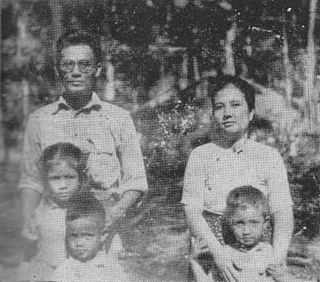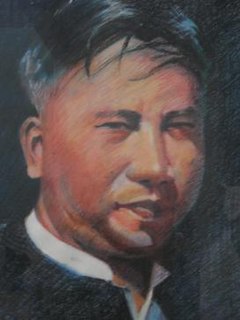
Nu, known honorifically as U Nu or Thakin Nu, was a leading Burmese statesman, politician, nationalist, and political figure of the 20th century. He was the first Prime Minister of Burma under the provisions of the 1947 Constitution of the Union of Burma, from 4 January 1948 to 12 June 1956, again from 28 February 1957 to 28 October 1958, and finally from 4 April 1960 to 2 March 1962.

The Anti-Fascist People's Freedom League (AFPFL) was the dominant political alliance in Burma from 1945 until 1958 consisting of political parties and mass and class organizations.

Thakin Chit Maung, also known as Widuya Thakin Chit Maung, was a veteran Burmese politician.

Ludu U Hla was a Burmese journalist, publisher, chronicler, folklorist and social reformer whose prolific writings include a considerable number of path-breaking nonfiction works. He was married to fellow writer and journalist Ludu Daw Amar.
Articles related to Myanmar include:

Thakin Soe was a founding member of the Communist Party of Burma, formed in 1939 and a leader of Anti-Fascist Organisation. He is regarded as one of Burma's most prominent Communist leaders.
Mukerjee, party name Yebaw Phyu Win, was a Bengal-born Burmese communist leader. Ahead of the Second World War, he took employment in the Defence Department. In 1939 he joined the Burmese Communist Party. In 1946, he was included in the leadership of the All Burma Trade Union Congress.
Wa Gyi was a Burmese communist leader.
The Shan State Communist Party was a communist party in Shan State, Burma. The party was founded in 1956 by Moh Heng, a commander of the Communist Party of Burma in Lawksawk, in protest of a decision by the CPB leadership to reject the creation of a separate party committee for Shan State.

The Ministry of Foreign Affairs is a ministry in the government of Myanmar responsible for the country's foreign relations. It also operates embassies and consulates in 44 countries. It is headed by Wunna Maung Lwin, appointed by millitary leader Min Aung Hlaing
Thakin Lwin was a Burmese politician and trade unionist, writer and journalist. He was a leading member of the anti-colonial Dobama Asiayone movement, a parliamentarian, the president of the Trade Union Congress (Burma) and a prominent leader of the Burma Workers and Peasants Party.
The Burma Socialist Party, initially known as the People's Freedom (Socialist) Party or PF(S)P, was a political party in Burma. It was the dominant party in Burmese politics after 1948, and the dominant political force inside the Anti-Fascist People's Freedom League.
The Trade Union Congress (Burma) was a central trade union organization in Burma. The TUC(B) was founded by the Socialist Party in November 1945, in an attempt to counter the influence of the communist-led All Burma Trade Union Congress. Ba Cho was the President of TUC(B). The TUC(B) was an affiliate of the governing Anti-Fascist People's Freedom League.
The Burma Trade Union Congress was a central trade union organization in Burma. The BTUC was founded in December 1950 as the trade union wing of the Burma Workers and Peasants Party. BTUC was formed after a split away from the Trade Union Congress (Burma). Thakin Lwin, former Minister of Labour (1948-1949), served as the president of BTUC. BTUC was affiliated to the World Federation of Trade Unions.

The Communist Party (Burma), sometimes referred to as the Red Flag Communist Party, was a communist party in Burma. The party was formed after a more radical faction broke away from the Communist Party of Burma in 1946. In the same year, it began a protracted armed insurgency; first against British rule, then against the Burmese government. The party was led by Thakin Soe, a firebrand communist leader. In the mid to late 1970s, the party lost influence and was militarily defeated after the capture of Thakin Soe in 1978.
Amar Nag alias Yebaw Tun Maung or U Hla (1917–1968), was one of the founding leaders of the communist movement in Burma. Dr. Nag was active in the struggle for Burmese independence. He was an important leader of the Communist Party of Burma, but was killed in an ambush in 1968.
Thakin Kyaw Tun, or Thakin Kyaw Dun was a Burmese politician.

Kyaw Nyein, called honorifically U Kyaw Nyein (Burmese: ဦးကျော်ငြိမ်း;pronounced [ʔú t͡ɕɔ̀ ɲeɪɴ], was a Burmese lawyer and anti-colonial revolutionary, a leader in Burma’s struggle for independence and prominent politician in the first decade after the country gained sovereignty from Britain. He held multiple minister portfolios in the government of Prime Minister U Nu, served as General Secretary of the ruling political alliance, Anti-Fascist People's Freedom League, and was joint General Secretary of the Burma Socialist Party BSP.

The communist insurgency in Myanmar was a conflict fought primarily by the Communist Party of Burma and the Communist Party (Burma) from 1948 to 1988. The conflict ended when the armed wing of the Communist Party of Burma disbanded following the Fall of Communism and the ousting of the Burmese socialist dictatorship.









